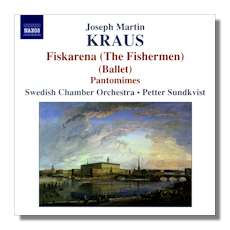
The Internet's Premier Classical Music Source
Related Links
- Kraus Reviews
- Latest Reviews
- More Reviews
-
By Composer
-
Collections
DVD & Blu-ray
Books
Concert Reviews
Articles/Interviews
Software
Audio
Search Amazon
Recommended Links
Site News
 CD Review
CD Review
Joseph Martin Kraus

Ballet Music
- Fiskarena, VB 40
- Pantomime in D Major, VB 37
- Pantomime in G Major, VB 38
- Ballet Music for Gluck's "Armide", VB 39
Swedish Chamber Orchestra/Petter Sundkvist
Naxos 8.557498 DDD 69:39
While ballet certainly existed, preference was given to opera during the Classical era. Until now, Beethoven's The Creatures of Prometheus and Mozart's Les Petits Riens were the only examples of free-standing ballets from that era that readily came to my mind. Now I can add a third: Fiskarena (The Fishermen) by Mozart's contemporary, Joseph Martin Kraus (1756-1792).
Kraus, like Mozart, died tragically young, yet he accomplished a lot during his brief time on earth. He became known as "the Swedish Mozart" for the time he spent at the court of King Gustavus III in Stockholm. (This is the same Gustavus whose assassination was the inspiration behind Verdi's Un ballo in maschera.) Early in Kraus's tenure, the king sent the young composer around Europe, apparently to make sure that Sweden kept au courant with the latest trends in music and theater. One of Kraus's acquaintances was Franz Joseph Haydn, who referred to Kraus as one of the two geniuses he had met. (The other was Mozart.)
Indeed, Kraus's music is very fine, although it probably isn't very fair to compare him to Mozart. Then again, if you compare Fiskarena to Les Petits Riens, Kraus doesn't seem inferior to Mozart anyway. This ballet was premièred by the Royal Ballet in Stockholm in1789, with choreography by Antoine Bournonville. (His son August, who subsequently went to Denmark, is credited with being the father of Romantic ballet.) The plot is slim: a local fisherman's daughter wants to wed the English sailor Jack, but her father wants her to marry the merchant Ambrosius. Jack plots a tryst between Ambrosius and a gypsy girl, and the merchant's subsequent discomfiture makes it possible for Jack to marry the girl. The ballet has an overture and 20 sections, most shorter than three minutes. Kraus's European travels served him well; not only does Jack dance to the famous Hornpipe, the penultimate number is a Hungarian-styled Ungherese. The music is bright as a newly-minted penny, and very pleasant, although it doesn't seem very memorable.
The two Pantomimes (each one less than eight minutes long) probably date from Kraus's student years. They may have been written for use during Carnival seasons. Again, they are enjoyable but not of earth-shattering impact. "Earth-shattering" might describe the second of two numbers written for interpolation into a Swedish production of Gluck's Armide in 1787, if only because it sounds like typical "storm at sea" music from that era. The other interpolated number is an arrogant minuet, marked Fieramente (proudly).
This music has been prepared for recording and publication by Bertil van Boer, who also wrote the very complete booklet notes. The publisher is Artaria Editions, who has an extensive working relationship with Naxos.
Sundkvist and the Swedish Chamber Orchestra are not strangers to Naxos, nor to Kraus' music, and the performances are stylish and full-blooded. The excellent recording was made in the SCO's home city of Örebro.
Copyright © 2008, Raymond Tuttle




















